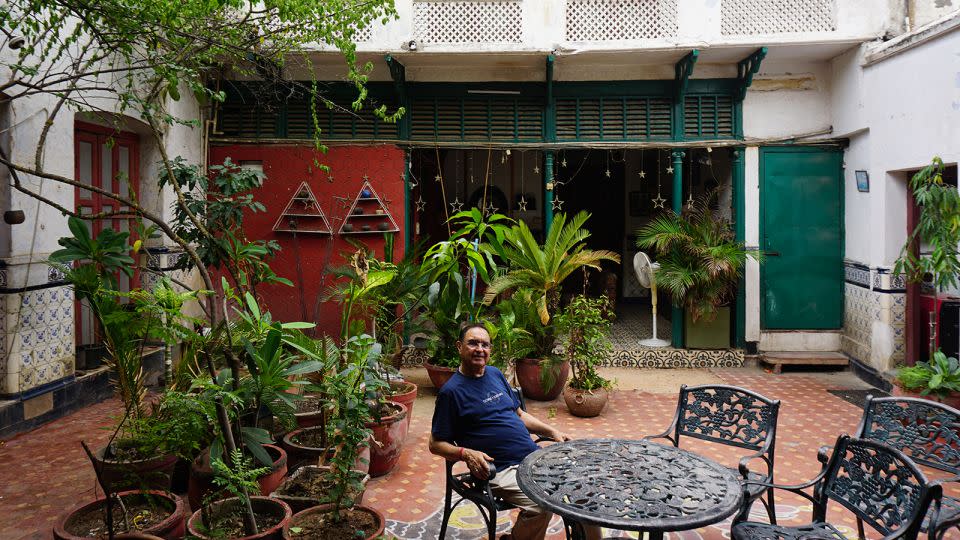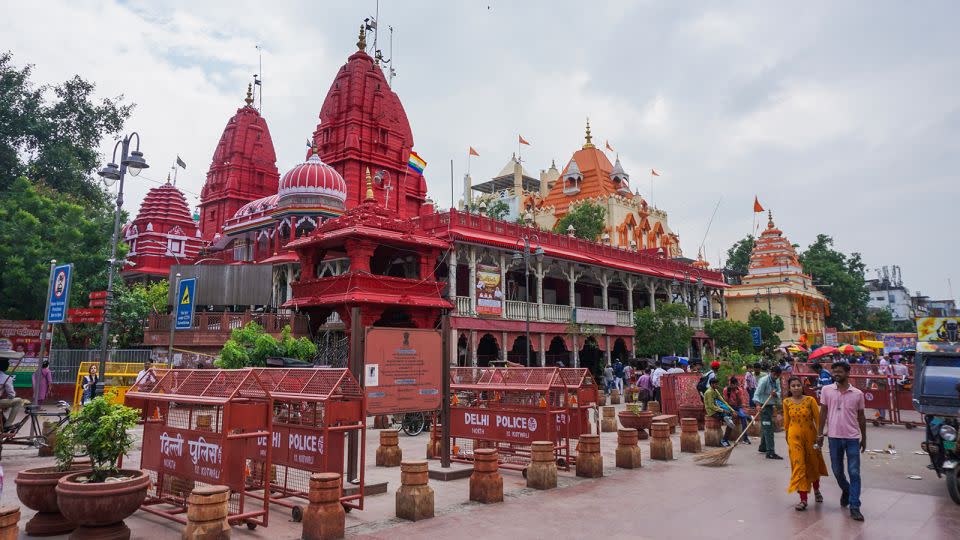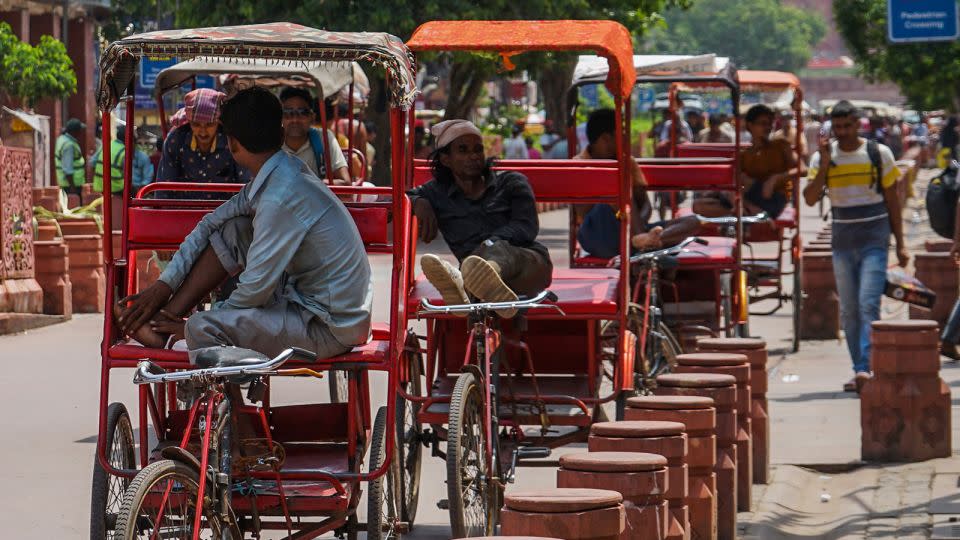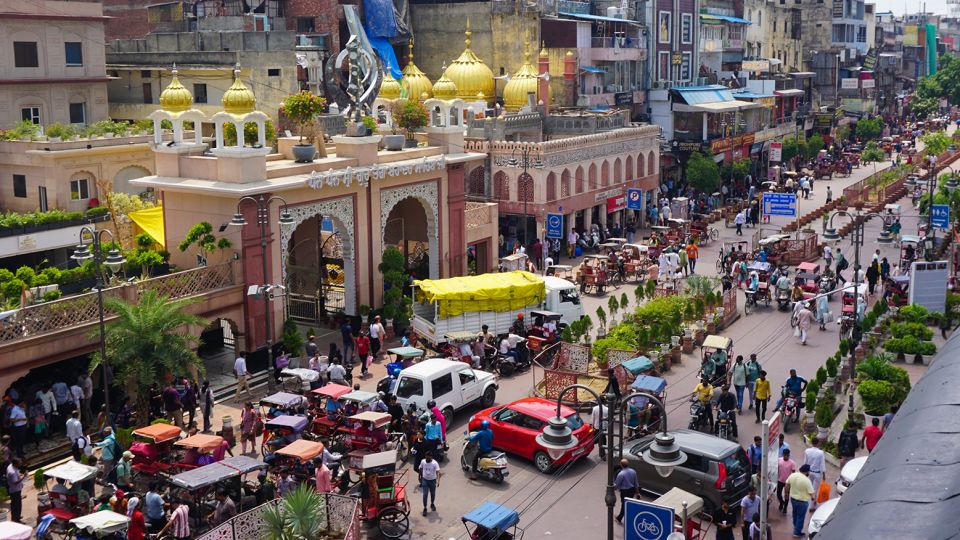Chandni Chowk was once the kind of neighborhood that people spoke of with awe.
Built in the 17th century by Emperor Shah Jahan, it reflected the wealth of the once-mighty Mughal Empire and quickly became one of India’s most sought-after districts, where the rich and powerful lived in fashionable mansions.
Today, this corner of the historic walled city of Old Delhi has a different atmosphere, drawing visitors to a vibrant street food scene. Architectural reminders of its former glory are still visible, but the chic homes of the wealthy are no more; many have been converted into hotels or other businesses and their residents are long gone.
But not Ajay Parshed.
At 80, but still going strong, Parshed sits in the courtyard of his grand 120-room ancestral mansion, almost the last man of Chandni Chowk’s old guard, clinging to the splendor of a bygone era.
“It is the only living mansion on the historic street of Chandni Chowk,” says Parshed, a descendant of Chunna Mal, a moneylender and businessman who built the house long ago, according to an inscribed gold plaque in the building’s hallway, in 1864.
Some 160 years later, although Parshed clings to the legacy of his ancestors, much of the glamor of previous centuries has disappeared. Most of the mansion’s rooms are locked and unused. The antiques inside are collecting dust.


And of Chunna Mal’s 32 heirs, only Parshed and his family of 10 remain. And, he says, he’s the only one who wants to keep the place.
“The family is planning to sell, but I am against it,” he says. “I tried to put them on the same table.” Parshed says he hopes one of the few private mansions in the area isn’t converted into a hotel.
Talking about the glory of the street, Khan says that there used to be an octagonal pool that reflected and sparkled the moon in the water. Hence the name Chandni Chowk: “Moonlit Crossing.”
During the time of the Mughal Empire, which was founded in the 16th century and grew to control much of the Indian subcontinent before shrinking and dissolving in 1857, India’s cultural and architectural heritage included numerous iconic structures.
In Delhi these include the Humayun’s Tomb, the Jama Masjid (mosque) and the Old Fort. The neighboring city of Agra received the Taj Mahal. It has been designated as one of the Seven Wonders of the World and attracts thousands of visitors every day.
And then there was Chandni Chowk, built as part of Emperor Shah Jahan’s new capital, Shahjahanabad – or Old Delhi as it later became.
Many parts of this street were destroyed when the people revolted against the British occupation in 1857. The British crushed the rebellion, ending Mughal rule in Delhi and marking the beginning of the British Raj.
However, mansions like those of Chunna Mal’s family remained untouched. “Chunna Mal was pro-British. We therefore enjoyed many privileges,” Parshed explains.
His ancestor, he says, was appointed the first Municipal Commissioner of Old Delhi.
Today, Parshed House stands as a symbol of both the glory of the 17th century and the way it is changing or forgotten today.


The moonlit crossing
The somber spaciousness within the sprawling mansion is also in stark contrast to the modern Chandni Chowk Road outside.
Right in the heart of Delhi, the district’s oldest street starts at the entrance of the Mughal-era Red Fort, where the annual flag-raising on Independence Day is supervised by the Indian Prime Minister, and stretches 1,300 meters out to the 17th century Fatehpuri Mosque.
Bustling with businessmen, cycle rickshaws and shoppers who come to buy clothes and jewelery or eat the delectable food, it attracts thousands of tourists and visitors every day.
For Rameen Khan, the founder of the company City stories which organizes heritage walks and tours in and outside Delhi, the importance of this road extends beyond its material offering.
“In its nooks and corners, this street has preserved more than three and a half centuries of Indian history. It hides in plain sight, unnoticed and unappreciated, but a testament to the unfolding of India’s past,” he says.
According to Khan, there once stood an octagonal pool here that would sparkle with reflections of the moon. Hence the name Chandni Chowk, which means ‘moonlit crossing’.
“Since this was the largest part of the route, it is fitting that the entire route is named after it,” Khan added.
History and faith knots
It is not just multiple eras of history that are intertwined here in this piece of old Delhi. Several places of worship coexist in Chandni Chowk: a Jain temple, a Hindu temple, a mosque, a Sikh shrine and a Baptist church.
“This shows that India is able to coexist peacefully as a secular country despite many challenges,” Khan said.
Sheetal Saxena, 23, a housewife and local resident, says there is still good friendship between the different communities here. “The fact that this place is suitable for everyone makes it truly emblematic of India,” she says.
These religious centers are also tourist attractions, especially the reddish pink Digambar Jain Lal Temple. It is revered by those who follow the Indian religion Jainism, which emphasizes non-violence and a strict diet that eschews garlic and onions.
Originally built in the 17th century, the temple was renovated in 1878 with red sandstone, earning it the nickname the Red Temple.
At a time when the Mughal Empire was losing its grip on the country, a nobleman in his army built a Hindu temple dedicated to the god Shiva in the 1760s. “Other groups were now becoming stronger. You can see that in the construction of a temple so close to the Mughal throne,” says Khan.
On the other side of the road is the Central Baptist Church, which dates back to the British colonial era. According to Khan, the original Christian church was destroyed during the 1857 uprising and later rebuilt. But travelers who know where to look can go inside, where they will find inscriptions of prayers and commandments in Urdu on gold-colored plates.


Another symbol of the declining Mughal empire lies in the Golden Mosque, where Persian Emperor Nader Shah ordered the sack of Delhi in 1793.
Next to it, a Sikh shrine commemorates where one of the ten gurus who founded the faith was murdered. It was a police station during the Mughal era. After the Mughals lost power, the Sikhs built their temple – called a gurudwara – on that site.
For Khan, these buildings are a reflection of the different eras the neighborhood has experienced.
Finding a way forward
Locals say Chandni Chowk’s popularity increased recently when the local government of Delhi unveiled a new look and banned all traffic except rickshaws. New red sandstone paths were constructed to create a pedestrian area and more trees were planted.
Some say there is still a lot of work to be done.
Dilip Saxena, a local retiree who has lived in the area all his life, says the area off the main road is plagued by dirt, monsoon floods and building fires. He says the status of a residential area is being eroded.
“When I grew up here, there were thirteen houses in the area around my house. Now there are only two. People have sold their properties as commercial establishments and moved away,” he said.
One such commercial establishment is a new shopping center 100 meters from Chandni Chowk.
“With the arrival of the shopping centre, there is concern that the old-world charm of this area will be forgotten or changed over time. As generations continue to come, fewer and fewer people will know about this history and that is a concern,” says Saxena.
‘Will they stop at this shopping center, or build many more? Who knows?” he asks.
For Ajay Parshed too, this development is for the visitors, not for those who live here. “You can ban vehicles, but what do we residents do during medical emergencies?”
Despite this, Parshed is confident he won’t leave. “This is my family’s rich history here. I can’t even think about leaving.”
For more CNN news and newsletters, create an account at CNN.com







